Configuring and Using PeopleSoft G-Invoicing
This topic discusses how to configure and use PeopleSoft G-Invoicing.
This table lists the pages used to configure and manage G-Invoicing.
|
Page Name |
Definition Name |
Usage |
|---|---|---|
|
INSTALLATION_FD |
To enable PeopleSoft G-Invoicing to run the APIs and view the G-Invoicing specific fields on the purchase order and receipt. |
|
|
PO_GINV_DEFN |
To capture fields required by G-Invoicing for messaging. |
|
|
PO_GNV_GTC_FL |
To view G-Invoicing General Terms and Conditions that have been pulled using the Pull GTCs API. |
|
|
PO_RUN_GINV_PROC |
To run the Pull GT&Cs API which populates the View General Terms and Conditions grid. |
|
|
PO_GNV_ORD_FL |
To view G-Invoicing orders that have been pulled using the Pull Orders API. |
|
|
PO_GINV_ORD_PROC |
To run the Pull Orders API which populates the View Orders grid. |
|
|
PO_GNV_PER_HDR_FL |
To view G-Invoicing Performance Transactions that have been pulled using the Pull Performance API. |
|
|
PO_GINV_PFM_PROC |
To run the Pull Performance transactions which populates the View Performance grid. |
|
|
PO_GINV_PFM_PUSH |
To run the Push Performance transactions API which sends Received/Accepted transactions and adjustments to G-Invoicing. |
Use the Federal Processing Options page (INSTALLATION_FD) to enable PeopleSoft G-Invoicing to run the APIs and view the G-Invoicing specific fields on the purchase order and receipt.
Navigation:
This example illustrates the fields and controls on the Federal Processing Options page. You can find definitions for the fields and controls later on this page.
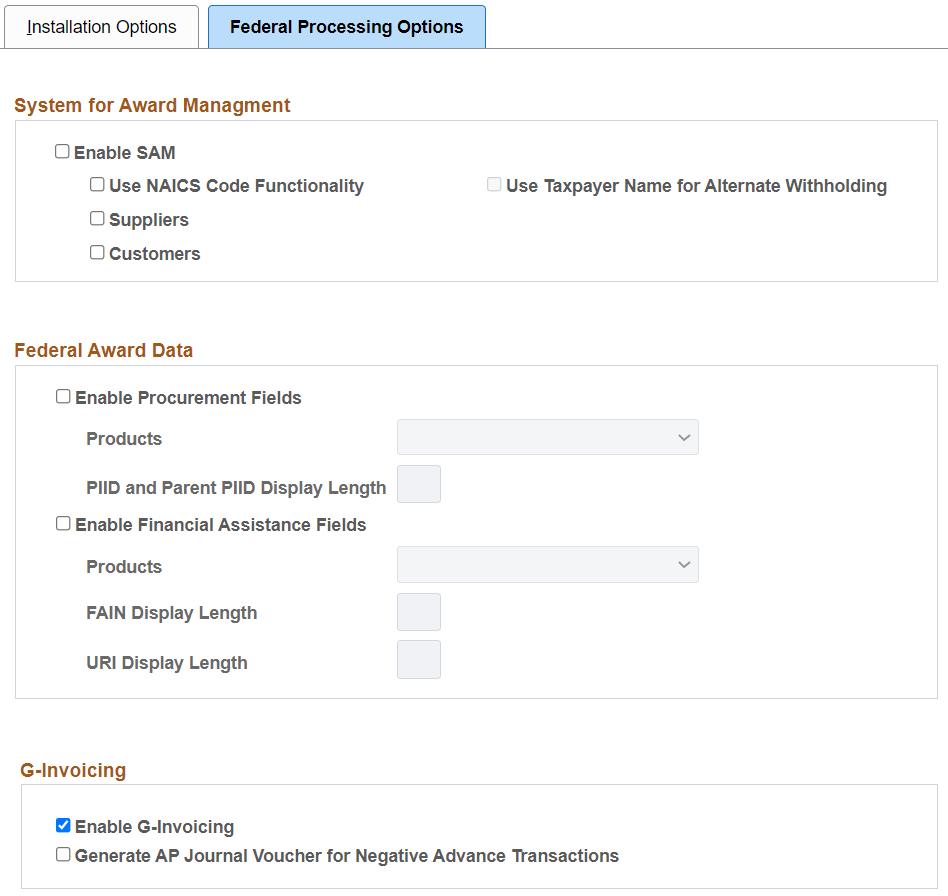
|
Field or Control |
Description |
|---|---|
|
Enable G-Invoicing |
Select to enable G-Invoicing fields and functionality. |
|
Generate AP Journal Voucher for Negative Advance Transactions |
Select to automatically create Journal Vouchers for negative advance adjustment performance transactions received from G-Invoicing. This field is visible only when Enable G-Invoicing is selected. |
The G-Invoicing Definition page (PO_GINV_DEFN) captures fields required by G-Invoicing for messaging. Additionally, this page stores the last date and time that each API ran for the selected G-Invoicing System ID. All G-Invoicing System IDs must be defined on this page. System IDs are used for security in G-Invoicing.
Navigation:
This example illustrates the fields and controls on the G-Invoicing Definition page. You can find definitions for the fields and controls later on this page.

|
Field or Control |
Description |
|---|---|
|
SetID |
Enter the Set ID associated with the System ID definition. |
|
System ID |
Enter the G-Invoicing System ID. |
|
Description |
Enter a description of the entry. |
|
G-Invoicing API |
Displays the available APIs. |
|
Last Updated Date (read only) |
Displays the date FROM which transactions are selected by the pull APIs. |
|
Last Updated Time (read only) |
Displays the time FROM which transactions are selected by the pull APIs. |
G-Invoicing navigation collection page is used to group the G-Invoicing inquiry pages together allowing a user to easily navigate from one component to another.
This example illustrates the fields and controls on the G-Invoicing page.
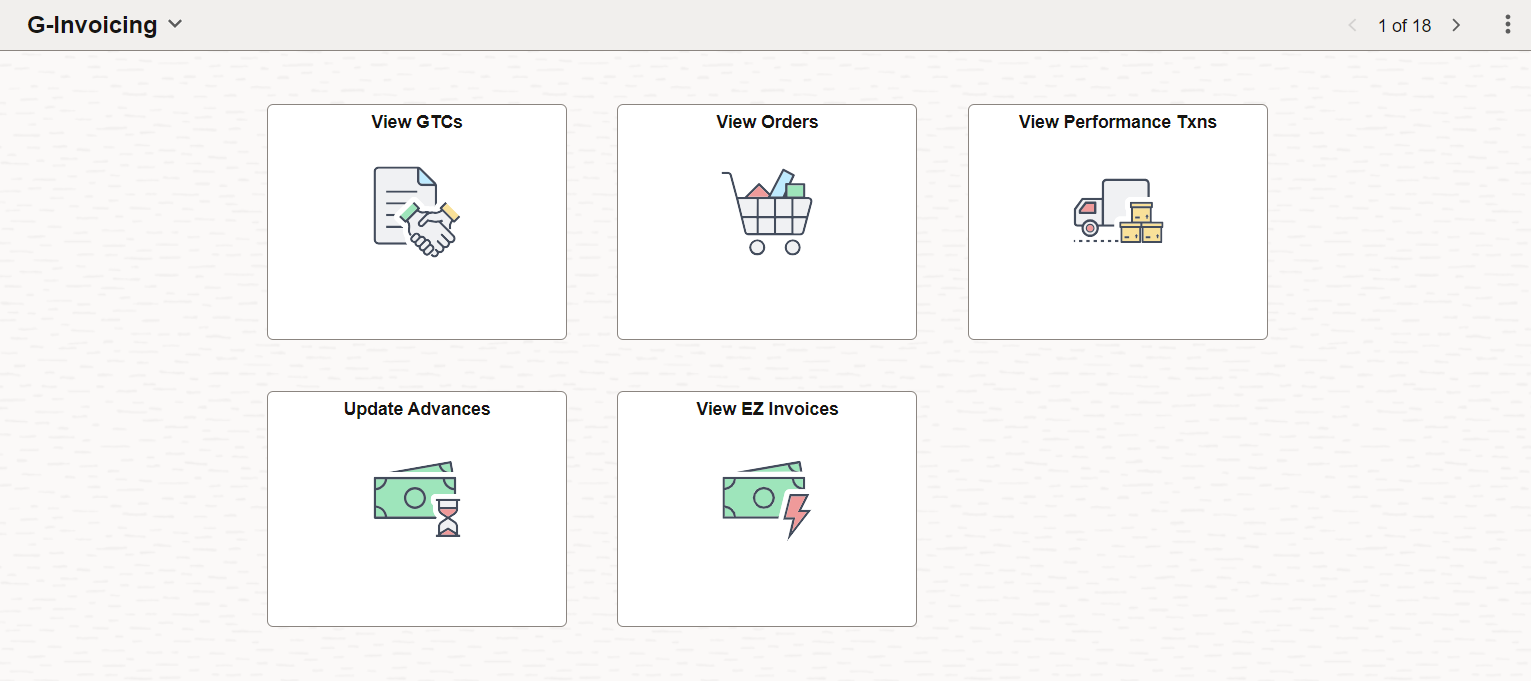
Use the GTCs (General Terms and Conditions) page (PO_GNV_GTC_FL) to view G-Invoicing General Terms and Conditions that have been pulled using the Pull GTCs API.
Navigation:
This example illustrates the fields and controls on the General Terms and Conditions page. You can find definitions for the fields and controls later on this page.
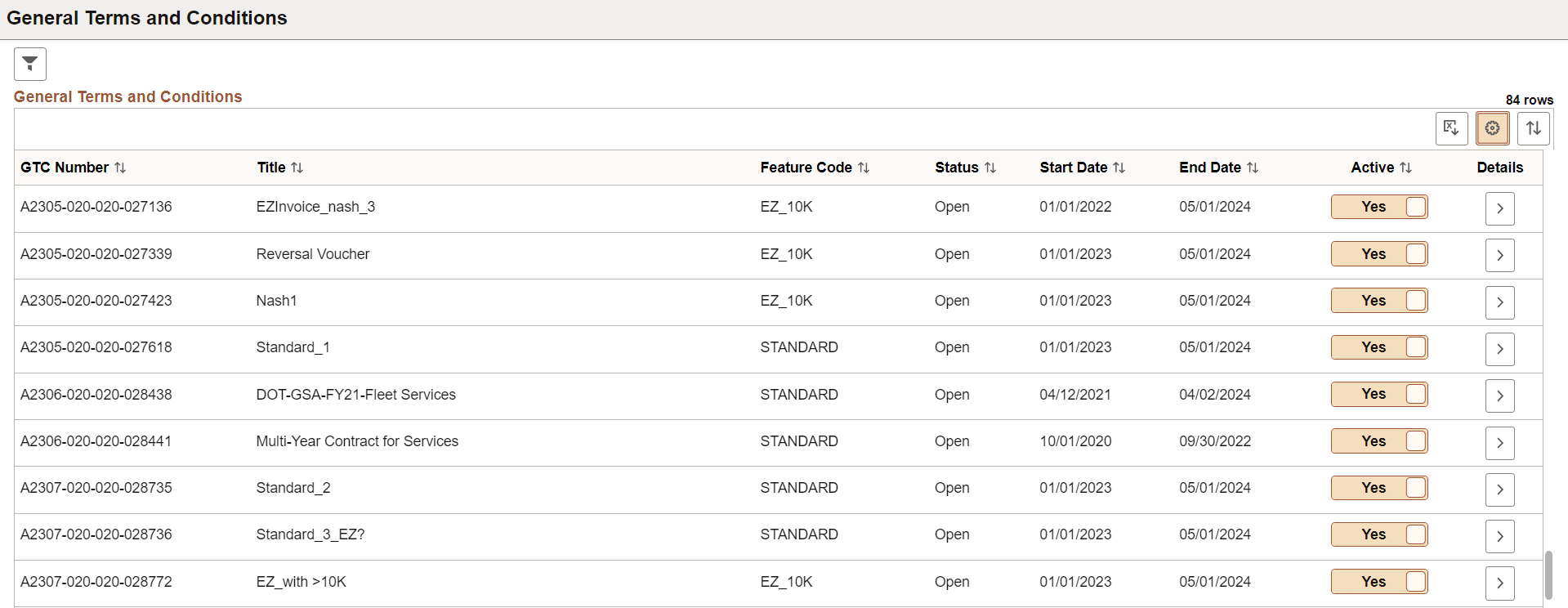
|
Field or Control |
Description |
|---|---|
|
SetID |
Displays the derived set ID associated with the G-Invoicing System ID on the G-Invoicing Definition page. |
|
GTC Number |
Displays the GT&C number assigned in G-Invoicing. |
|
Title |
Displays the GT&C Title entered in G-Invoicing. |
|
Feature Code |
Displays the G-Invoicing type:
|
|
Status |
Displays the GT&C Status received from G-Invoicing. |
|
Start Date |
Displays the GT&C Start Date entered in G-Invoicing. |
|
End Date |
Displays the GT&C End Date entered in G-Invoicing. |
|
Active |
Indicates whether the GT&C is available for selection on Purchase Orders. |
 |
Click to view the GT&C Detail page. Click the Select Last Updated Date drop down to see the GT&C changes that have occurred in G-Invoicing for a specific date/time. |
This example illustrates the fields and controls on the GT&C Detail page.

Use the G-Invoicing Pull GTCs page (PO_RUN_GINV_PROC) to run the Pull GT&Cs API which populates the View General Terms and Conditions grid. Only G-Invoice GTCs with a status of Open (REC) or Closed (CLZ) are pulled.
Navigation:
GT&Cs are entered directly into G-Invoicing and a subset of fields is pulled into PeopleSoft using this API. The GT&C Number is used for reference on purchase orders.
This example illustrates the fields and controls on the G-Invoicing Pull GTCs page. You can find definitions for the fields and controls later on this page.

|
Field or Control |
Description |
|---|---|
|
Run Control ID |
Enter a run control ID. |
|
Process Frequency |
Select how often the process should run. The available options are:
|
|
System ID |
Enter the System ID to use when pulling transactions from G-Invoicing. |
|
Last Updated Date and Last Updated Time |
Displays the last run date and time for the API. |
Use the Orders page (PO_GNV_ORD_FL) to view a list of G-Invoicing orders that have been pulled using the Pull Orders API.
Navigation:
This example illustrates the fields and controls on the Orders page. You can find definitions for the fields and controls later on this page.
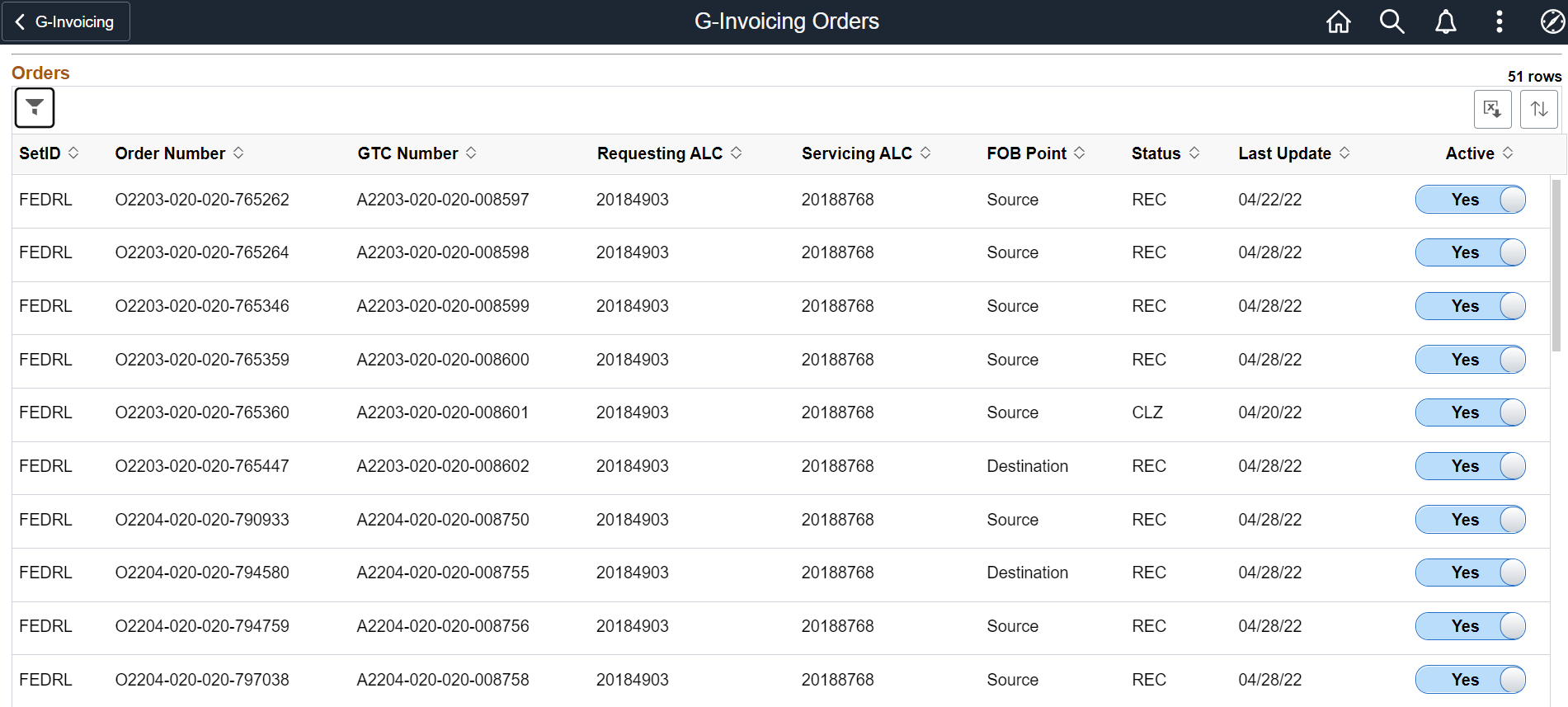
|
Field or Control |
Description |
|---|---|
|
SetID |
Displays the derived set ID associated with the G-Invoicing System ID on the G-Invoicing Definition page. |
|
Order Number |
Displays the Order Number assigned in G-Invoicing. |
|
GTC Number |
Displays the associated GT&C in G-Invoicing. |
|
Requesting ALC |
Displays the Requester’s Agency Location Code (ALC) from G-Invoicing. |
|
Servicing ALC |
Displays the Seller’s Agency Location Code from G-Invoicing. |
|
FOB Point |
Indicates whether the Order originated from the Requestor or Seller in G-Invoicing. |
|
Status |
Displays the Order Status in G-Invoicing. |
|
Last Update |
Displays the last date that the Order was updated by the API. |
|
Active |
Indicates whether the Order is available for selection on Purchase Orders. |
Use the G-Invoicing Pull Orders page (PO_GINV_ORD_PROC) to run the Pull Orders API which populates the View Orders grid. Only G-Invoice Orders with a status of Open (REC) or Closed (CLZ) are pulled.
Navigation:
This example illustrates the fields and controls on the G-Invoicing Pull Orders page. You can find definitions for the fields and controls later on this page.

Orders are entered directly into G-Invoicing and a list of orders is pulled into PeopleSoft using this API. The Order Number is used for reference on Purchase Orders.
|
Field or Control |
Description |
|---|---|
|
Run Control ID |
Enter a run control ID. |
|
Process Frequency |
Select how often the process should run. The available options are:
|
|
System ID |
Enter the System ID to use when pulling transactions from G-Invoicing. |
|
Last Updated Date and Last Updated Time |
Displays the last run date and time for the API. |
Use the Performance Transactions page (PO_GNV_PER_HDR_FL) to view G-Invoicing Performance Transactions that have been pulled using the Pull Performance API.
Navigation:
This example illustrates the fields and controls on the Performance Transactions page. You can find definitions for the fields and controls later on this page.

|
Field or Control |
Description |
|---|---|
|
SetID |
Displays the derived set ID associated with the G-Invoicing System ID on the G-Invoicing Definition page. |
|
Type |
Identifies the nature of the performance in the reported transaction:
|
|
Performance Number |
Displays the Performance Number assigned to the transaction in G-Invoicing. |
|
Order Number |
Displays the associated Order Number in G-Invoicing. |
|
GTC Number |
Displays the associated GT&C in G-Invoicing. |
|
Requesting ALC |
Displays the Requester’s ALC from G-Invoicing. |
|
Servicing ALC |
Displays the Seller’s ALC from G-Invoicing. |
|
Performance Date |
Displays the date of the performance transaction in G-Invoicing. |
|
In Process |
Identifies whether the transaction has one or more receipts created:
|
 |
Click to view the Performance Detail page. This page contains header and line data associated with the performance transaction. |
This example illustrates the fields and controls on the Performance Details page. You can find definitions for the fields and controls later on this page.

|
Field or Control |
Description |
|---|---|
|
SetID |
Displays the derived set ID associated with the G-Invoicing System ID on the G-Invoicing Definition page. |
|
Type |
Identifies the nature of the performance in the reported transaction:
|
|
Performance Number |
Displays the Performance Number assigned to the transaction in G-Invoicing. |
|
Order Number |
Displays the associated Order Number in G-Invoicing. |
|
GTC Number |
Displays the associated GT&C in G-Invoicing. |
|
PO Business Unit |
Displays the PO Business Unit from the set ID associated with the G-Invoicing System ID on the G-Invoicing Definition page. |
|
PO ID |
Click to view the Purchase Order in the PO Inquiry page. |
|
Buyer/Seller Indicator |
Indicates whether the performance transaction originated from the Requestor or Seller in G-Invoicing. |
|
Agency Transaction ID |
Displays the Agency Transaction ID from G-Invoicing. |
|
Reference Performance |
Links a new Performance Transaction to an existing one. |
|
Transaction Date |
Displays the date and time the performance transaction was enterred into G-Invoicing. |
|
Performance Date |
Displays the date and time of the performance transaction in G-Invoicing. |
|
Prepared By Name/Email/ Phone |
Displays the name, email address, and phone number for the preparer in G-Invoicing. |
|
Comments |
Click the Comments link to view Comments associated with the transaction. |
|
Line |
Displays the G-Invoicing performance line number. |
|
Quantity |
Displays the number of units pertaining to the type of performance being reported. |
|
UOM |
Displays the units in which a quantity is being expressed. |
|
Price |
Displays the price of the G-Invoicing line. |
|
Final |
Specifies from one partner to another that no more performance (of this type) is expected against the Order Schedule. This is a G-Invoicing field, not to be confused with the PeopleSoft partial/final flag. |
|
Status |
Displays the G-Invoicing status of the payment with IPAC. |
|
Disbursing Office |
Identifier assigned to the agency which is disbursing funds. |
|
Receipts |
Click to view Receipts created for this performance transaction. |
|
Vouchers |
Click to view Vouchers created for this performance transaction. |
|
Reference Line |
G-Invoicing reference line number that links a new Performance Detail to an existing one. |
|
Order Line |
G-Invoicing identifier of a specific line item within the order. |
|
Schedule Number |
G-Invoicing identifier of a specific schedule within the line item, containing the detailed financial and shipping information. |
|
Payment Transfer Date |
G-Invoicing date when the funds settled in IPAC. |
Note: It is possible that GT&C number could be blank on the Performance Inquiry table, if Pull Performance runs before Pull Orders. The GT&C Number is derived from the Orders data. To correct this issue, run Pull Orders and then Pull Performance again to populate GT&C Number.
Use the G-Invoicing Pull Performance page (PO_GINV_PFM_PROC) to run the Pull Performance transactions which populates the View Performance grid.
Navigation:
This example illustrates the fields and controls on the G-Invoicing Pull Performance page. You can find definitions for the fields and controls later on this page.
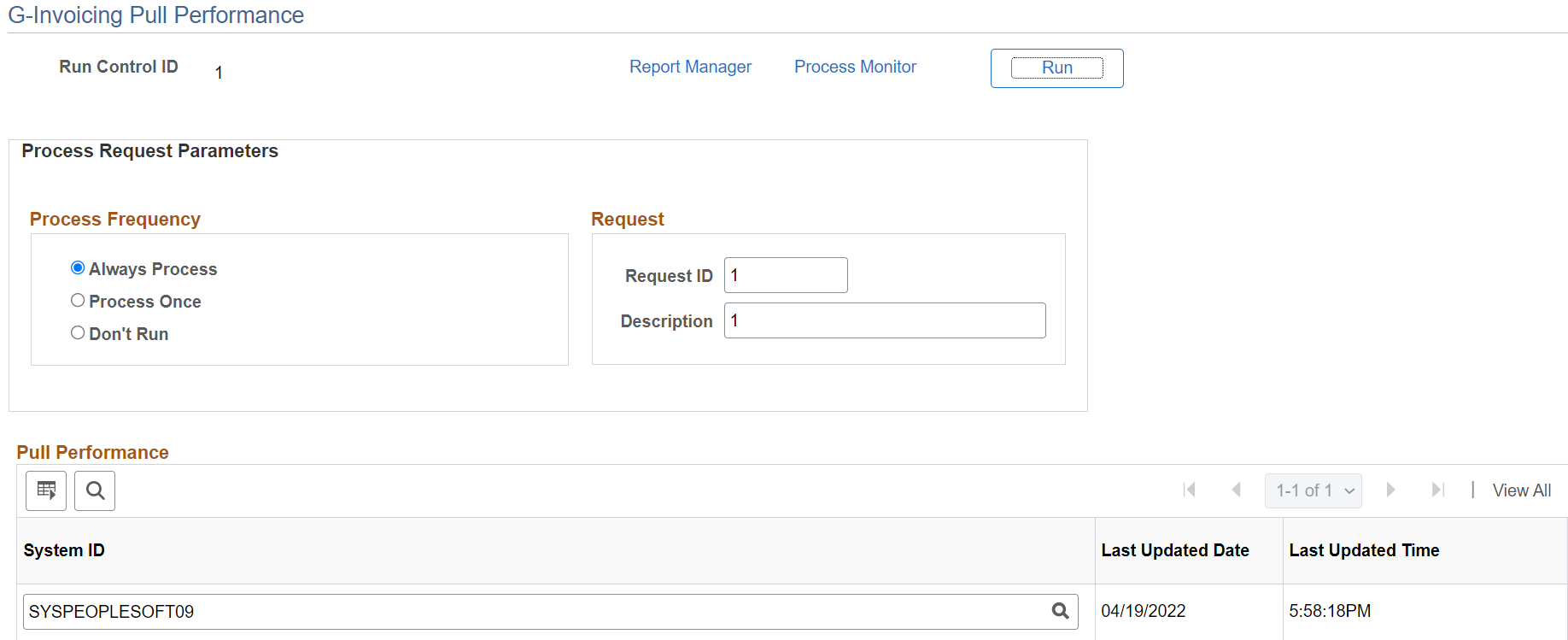
Performance transactions include:
Advance payments ('548’)
Adjustments to advances (negative ‘548’)
Delivered/performed transactions (‘035’)
Adjustments to delivered/performed transactions (negative ‘035’). These transactions are for informational purposes only and no transactions are automatically created. Since the specific reason for the adjustment is unknown, these transactions need to be reviewed and determine manual correction in Purchasing as necessary.
Received/accepted transactions (‘050’)
Adjustments to received/accepted transactions (negative ‘050’)
Deferred payment transactions (‘014’). For informational purposes.
|
Field or Control |
Description |
|---|---|
|
Run Control ID |
Enter a run control ID. |
|
Process Frequency |
Select how often the process should run. The available options are:
|
|
System ID |
Enter the System ID to use when pulling transactions from G-Invoicing. |
|
Last Updated Date and Last Updated Time |
Displays the last run date and time for the API. |
Use the G-Invoicing Push Performance page (PO_GINV_PFM_PUSH) to run the Push Performance transactions API which sends Received/Accepted transactions and adjustments to G-Invoicing.
Navigation:
This example illustrates the fields and controls on the G-Invoicing Push Performance page. You can find definitions for the fields and controls later on this page.
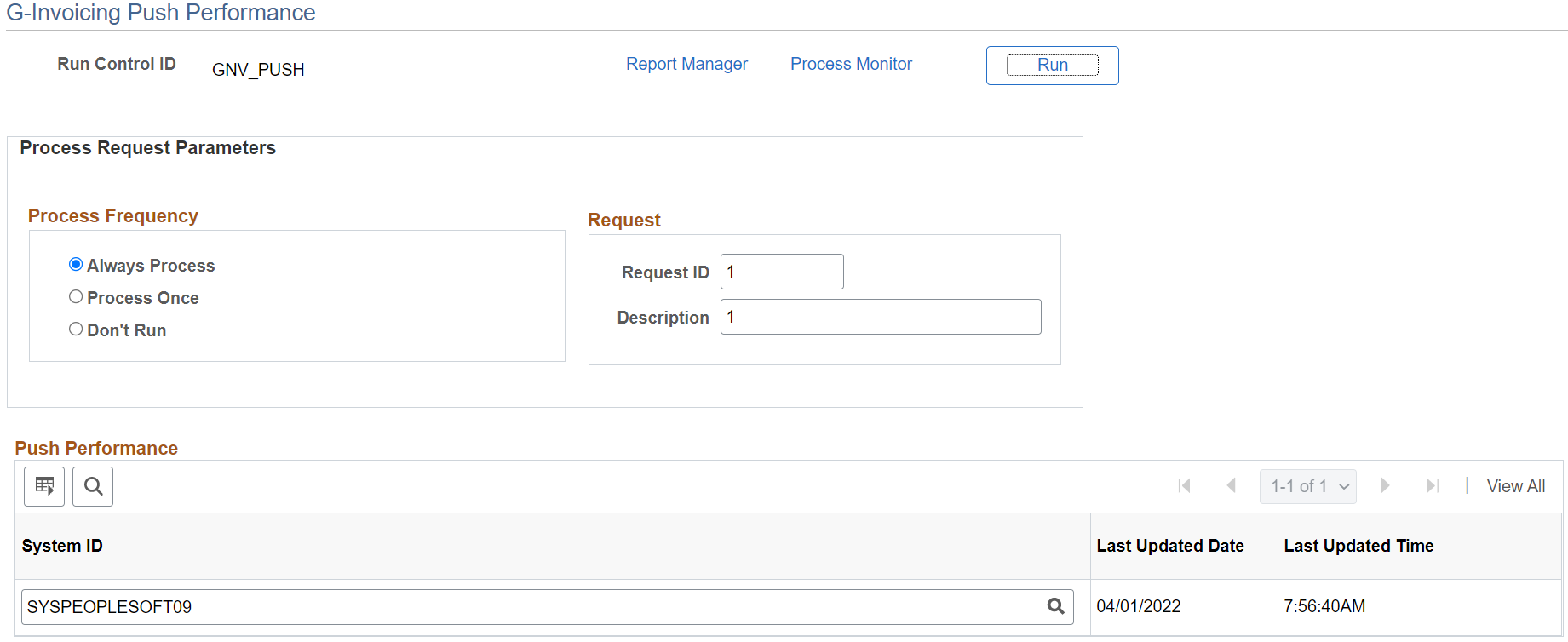
The following transactions are pushed back to G-Invoicing:
Received/accepted transactions (‘050’). These transactions originate from Receipts.
Adjustments to received/accepted transactions (negative ‘050’). These transactions originate from adjustments to Receipts and Return to Vendor transactions.
|
Field or Control |
Description |
|---|---|
|
Run Control ID |
Enter a run control ID. |
|
Process Frequency |
Select how often the process should run. The available options are:
|
|
System ID |
Enter the System ID to use when pulling transactions from G-Invoicing. |
|
Last Updated Date and Last Updated Time |
Displays the last run date and time for the API. |
Note: Pull Performance must be run prior to pushing RTV and receipt adjustment transactions so that the Reference Performance Number can be populated on the ‘050’ adjustment transaction. All ‘050’ adjustments must reference the Received/Accepted transaction (‘050’) they are adjusting. G-Invoicing assigns a performance number to a ‘050’ transaction after it is pushed using the API. This performance number becomes the reference performance number for the ‘050’ adjustment.
G-Invoicing must be enabled in Installation options and the Supplier ID must be classified as Federal, to view G-Invoicing specific fields on the purchase order.
Ensure that the Purchase Order entered in PeopleSoft matches the G-Invoicing Order lines and schedules exactly. The references are used to tie together all transaction activity between both systems.
|
Field or Control |
Description |
|---|---|
|
GTC Number |
Select GT&C number associated with the Order from the list. For more information, see PO Header Details Page |
|
G-Invoicing Order Number |
Select G-Invoicing Order Number associated with this PO from the list. For more information, see PO Header Details Page |
|
G-Invoicing Order Line |
Unique identifier for each line on the G-Invoicing Order. Defaults initially to the PeopleSoft PO Line Number. The Line numbers must match between the Order in G-Invoicing and PeopleSoft. For more information on purchase orders, see Maintain Purchase Order - Purchase Order Page |
|
G-Invoicing Order Schedule |
Unique identifier for the order schedule. Defaults initially to the PeopleSoft PO Schedule Number. The schedule numbers must match between the Order in G-Invoicing and PeopleSoft. For more information on schedules, see Maintain Purchase Order - Schedules Page |
G-Invoicing Performance Transactions classified as Delivered/Performed from the Supplier Agency are used to create Advanced Shipping Notifications (ASNs) in PeopleSoft. These ASNs become Advanced Shipping Receipts (ASRs) once loaded to Purchasing.
Performance transactions meeting the following criteria are selected for ASN creation:
Performance type is Delivered/Performed or ‘035’.
In Process flag on the Performance Inquiry table must not be Complete.
Performance transaction not previously processed into an ASR.
Performance transaction is NOT an Adjustment (Reference Performance field is blank).
The Pull Performance API loads all eligible delivered/performed performance transactions to the ASN staging tables.
Use Advanced Shipment Receipts page (Purchasing> Receipts> Review Receipt Information> Advanced Shipment Receipts) to view the staged shipments. Use Load Purchase Order Receipts page (Purchasing> Receipts> Load Receipts) to create Receipts from the staged ASR transactions.
For additional information, see Loading Receipts Received Using EIPs and EDC
Creating G-Invoicing Receipts Manually
It is possible to bypass the ASN/ASR process and create G-Invoicing receipts manually.
Pull Performance will create ASNs for all eligible ‘035’ transactions. These transactions can either be ignored or canceled. Processing them in addition to creating a receipt manually will cause duplicate entries.
This example illustrates the fields and controls on the Advanced Shipment Receipts page

To designate the receipt as G-Invoicing so that the Push Performance API generates a ‘050’ transaction, the following fields are required to be entered:
Referenced PO ID is required and the selected PO must be designated as G-Invoicing.
Shipment Number must be entered with the exact G-Invoicing Performance Number from the Seller agency.
Invoice Number must be entered.
Ship and Receipt Date must be entered as the G-Invoicing Performance Date.
Note: All Received/Accepted (‘050’) transactions and adjustments to Received/Accepted (negative ‘050’) transactions must either be entered in PeopleSoft OR in G-Invoicing but not both. Entering ‘050’ transactions directly into G-Invoicing and PeopleSoft will cause errors and reconciliation issues.
The G-Invoicing receipts are in an open status after the Load Receipts process is run.
A user must verify and confirm the Receipt Quantity on the line as well as enter an Invoice Number. The receipt status changes to Fully Received, once saved.
Note: The Receipt Quantity entered on the PeopleSoft receipt cannot exceed the quantity that the Supplier Agency reported on the delivered/performed (035) transaction or the push back to G-Invoicing will fail.
For additional information, see Maintain Receipts - Receiving Page
Now the Receipt is eligible to be pushed back to G-Invoicing as a received/accepted (050) performance transaction. Use the G-Invoicing Push Performance page to run the Push Performance API which sends eligible receipts to G-Invoicing.
In addition to Receipts, the Push Performance API sends the following transactions to G-Invoicing:
Updated receipts in a Received status are sent as received/accepted adjustments. When the receipt has been previously sent, the difference in quantity between the original and the adjustment is sent. Canceled G-Invoicing receipts are also sent.
Return to Vendor (RTV) transactions that reference a G-Invoicing designated receipt and are in a Shipped status are sent as received/accepted adjustments. Canceled G-Invoicing RTVs are also sent.
Adjustments to delivered/performed transactions (negative ‘035’) must originate from the seller and are included in the Pull Performance API. No transactions are automatically created for negative ‘035’ transactions since the reason for the adjustment and the corrective action are not known. These transactions must be reviewed and handled manually in PeopleSoft.
For example, a G-Invoicing Order is created for a quantity of 100. The Seller sends a Delivered/Performed (‘035’) transaction to the Requester for a quantity of 100 when the items are shipped. The Requester and the Seller have agreed to an FOB Point of Source, so an IPAC payment with a quantity of 100 is triggered in G-Invoicing when the Delivered/Performed (‘035’) transaction is created. 20 items were lost in transit and the Requester sends a Received/Accepted (‘050’) transaction for a quantity of 80 back to the Seller. To account for this in G-Invoicing and refund the quantity in IPAC, the Seller enters a negative Delivered/Performed (‘035’) transaction with a quantity of -20. This negative 035 is sent back to PeopleSoft in the Pull Performance API. If this negative 035 is processed, then amounts and quantities in PeopleSoft and G-Invoicing will not match.
Note: Received/Accepted (‘050’) transactions with multiple lines are assigned a unique Performance Number for each line by G-Invoicing.